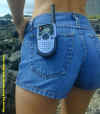Motorola TalkAbout
Words & Pictures: Marcus
Models: Flo Jalin & Lisa Volk
 So,
you have to speak with someone who is out of
So,
you have to speak with someone who is out of shouting range? You may need a Motorola TalkAbout. Communication,
that's what these little units are all about. Make it a short
range though. "... a way to communicate with members of a group
who are out of speaking range or sight but still in the general
area." That's from Motorola's official press release, and it
does a good job of describing the intended range. If you want to
put a number on the range, and if you're believing Motorola, it's
about 2 miles. With a big asterisk always following that number
2. The asterisk states; �depending on obstructions.' Well, I guess
that's fair. It's not going to have 2 miles of range in downtown
New York. In my neighborhood, I only was able to travel 1 kilometer
(about 0.62 of one mile) before contact was completely lost. But
as I have mentioned in other articles on this site, there are
shouting range? You may need a Motorola TalkAbout. Communication,
that's what these little units are all about. Make it a short
range though. "... a way to communicate with members of a group
who are out of speaking range or sight but still in the general
area." That's from Motorola's official press release, and it
does a good job of describing the intended range. If you want to
put a number on the range, and if you're believing Motorola, it's
about 2 miles. With a big asterisk always following that number
2. The asterisk states; �depending on obstructions.' Well, I guess
that's fair. It's not going to have 2 miles of range in downtown
New York. In my neighborhood, I only was able to travel 1 kilometer
(about 0.62 of one mile) before contact was completely lost. But
as I have mentioned in other articles on this site, there are a lot of above ground telephone wires. Without those wires I bet
that the range could easily double. I did get a lot more range at
the beach, around 2 miles just like Motorola said. The 2 mile range
limit is not a function of Motorola, it is the F.C.C. The Feds control
the radio frequencies, and when they allotted the frequencies for
the family channel radios they said low power transmitters only
with a range limit of two miles. Whether this range is adequate
or not depends solely on you. If you are running up your cell phone
bill with your friends at a location such as a mall trying to locate
them then you could really benefit from a TalkAbout. And don't forget
that cell phones will not work in many locations
a lot of above ground telephone wires. Without those wires I bet
that the range could easily double. I did get a lot more range at
the beach, around 2 miles just like Motorola said. The 2 mile range
limit is not a function of Motorola, it is the F.C.C. The Feds control
the radio frequencies, and when they allotted the frequencies for
the family channel radios they said low power transmitters only
with a range limit of two miles. Whether this range is adequate
or not depends solely on you. If you are running up your cell phone
bill with your friends at a location such as a mall trying to locate
them then you could really benefit from a TalkAbout. And don't forget
that cell phones will not work in many locations  outside
of cities. So these TalkAbouts would really be great for mountain
biking, skiing / snowboarding, fishing and so on. One place that
a TalkAbout radio really helps me is at a swap meet. Going to a
large car swap meet to find a special part means that you are going
to do a lot of walking. If you go with three people to this swap
meet and each of you have a TalkAbout, then you can split up and
cover the area in one third the time. So, it's up to you whether
or not you want or need a TalkAbout.
outside
of cities. So these TalkAbouts would really be great for mountain
biking, skiing / snowboarding, fishing and so on. One place that
a TalkAbout radio really helps me is at a swap meet. Going to a
large car swap meet to find a special part means that you are going
to do a lot of walking. If you go with three people to this swap
meet and each of you have a TalkAbout, then you can split up and
cover the area in one third the time. So, it's up to you whether
or not you want or need a TalkAbout.
They operate like the
walkie-talkies from your youth. They are single duplex so only one person can talk at a time. You have to
press a button down and talk and release it to listen. When we were
using the TalkAbouts, we would say "over" after we said
something so that we both weren't trying to speak at the same time.
Just like the old war movies.
single duplex so only one person can talk at a time. You have to
press a button down and talk and release it to listen. When we were
using the TalkAbouts, we would say "over" after we said
something so that we both weren't trying to speak at the same time.
Just like the old war movies.
As you can see from the pictures, these Motorola TalkAbout two-way radios are small (3 1/2 inches tall), but what you can't tell is how much they weigh. A scant 5.3 ounces with battery. That's really not that heavy. They're also water-, dust-, and shock-resistant so you can really abuse these things. They work for about 12 hours on a single charge of their nickel metal hydride battery. Of course to get 12 hours of time out of a battery charge, only about 10 percent of that time can be spent talking. If you need more time then that, you can put three double A's into the unit for some 30 hours of use.
So you might be wondering, "well what happens if everybody starts using these two-way radios? Won't you always be interrupted by other peoples conversations?" There are two good reasons why that won't happen. First reason; with only a 2 mile range, you don't have to worry about picking up stray signals from far away. The second reason is; there are 14 channels each with 38 eliminator codes. Eliminator codes filter out unwanted messages on the same frequency. So people can still listen in on your conversation, but they cannot interrupt you.
Motorola has actually won awards for the design of these things. One award came from the Industrial Design Society of America just because the thing looks cool. As you can see in the photographs, they do look cool. Motorola has even seen fit to provide the radios in different colors.
 Motorola
sent me two different versions of the TalkAbout, the SLK 280 (silver
and black) and the SLK 289 (blue and black). The most noticeable
difference between the to use is the ability of the 289 to be completely
hands free without any attachments. Both radios can be used in a
hands free mode, but with the 280, you must use a external headphone
with an attached microphone. While the 289 also has the ability
to use a external headset, you can also just rest it on a table
and talk to it as if it were a normal speaker phone. With that feature,
it could be used as a baby monitor. Motorola even lets you choose
the degree of sound that the microphone will pick up.
Motorola
sent me two different versions of the TalkAbout, the SLK 280 (silver
and black) and the SLK 289 (blue and black). The most noticeable
difference between the to use is the ability of the 289 to be completely
hands free without any attachments. Both radios can be used in a
hands free mode, but with the 280, you must use a external headphone
with an attached microphone. While the 289 also has the ability
to use a external headset, you can also just rest it on a table
and talk to it as if it were a normal speaker phone. With that feature,
it could be used as a baby monitor. Motorola even lets you choose
the degree of sound that the microphone will pick up.
Also, these Motorola
radios have a very powerful speaker in them which allows them to still be useful in conditions high noise
like at this windy beach.
them which allows them to still be useful in conditions high noise
like at this windy beach.
 There
are too many features to describe in this article. However I will
mention a few of the more important ones. The radios both have a
blue back light so that you can read the display in the dark. The
same button which illuminates the screen also locks the units keypad
preventing unwanted channel switching. Both units are able to scan
channels for activity allowing you to communicate with people without
having to first agree upon a channel and code. There are even different
alert sounds that the radios will make to announce that a message
is being received.
There
are too many features to describe in this article. However I will
mention a few of the more important ones. The radios both have a
blue back light so that you can read the display in the dark. The
same button which illuminates the screen also locks the units keypad
preventing unwanted channel switching. Both units are able to scan
channels for activity allowing you to communicate with people without
having to first agree upon a channel and code. There are even different
alert sounds that the radios will make to announce that a message
is being received.
 There
are other family channel radios on the market, most of which are
cheaper compared to the Motorola TalkAbout. Cheaper in both price
and quality. Because these TalkAbouts are so small and robust and
loaded with features, I'll recommend them over the competition.
If you're in the market for a two-way radio check out the competition
first, then head over to a store that sells Motorola.
There
are other family channel radios on the market, most of which are
cheaper compared to the Motorola TalkAbout. Cheaper in both price
and quality. Because these TalkAbouts are so small and robust and
loaded with features, I'll recommend them over the competition.
If you're in the market for a two-way radio check out the competition
first, then head over to a store that sells Motorola.
M.